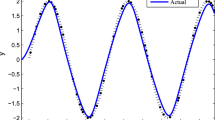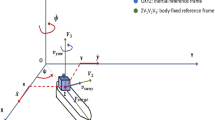Abstract
The current work aims at developing a nonlinear, self-tuning, robust observer to estimate state variables pertinent to the control of under-actuated marine surface vessels. The state estimator combines the advantages of the variable structure systems theory with those of the self-tuning fuzzy logic algorithm. It does not require an exact knowledge of the system dynamics or the construction of a rule-based expert fuzzy inference system. However, the upper bounds of both modeling imprecision and external disturbances must be known. The convergence of the estimation process is guaranteed by forcing the tuning parameters to satisfy inequalities stemming from the sliding conditions. The observer has been implemented herein to provide accurate estimate of the state variables that are needed by an integrated guidance and control system for the autonomous operation of an under-actuated marine surface vessel. The observer along with the integrated guidance and control system have been tested on a six degree-of-freedom ship model that considers numerous uncertainties associated with wave excitation, nonlinear restoring forces, retardation forces, sea-current and wind resistive loads. The theoretical results prove that the proposed self-tuning observer can produce accurate estimates of the state variables in the presence of significant modeling imprecision and environmental disturbances. In addition, they illustrate the use of estimated state variables in the guidance and control system with minimal impact on the close-loop performance of the marine vessel.


















Similar content being viewed by others
Abbreviations
- \(F_{\mathrm{rud}_{y}}\) :
-
Combined \(y\)-components of the lift and drag forces on the rudder
- \(F_{\mathrm{rud}_{y}}\) :
-
Combined \(y\)-components of the lift and drag forces on the rudder
- \(F_\mathrm{th\_cont}\) :
-
Propeller control thrust
- \(H_{1/3}\) :
-
Average height of the highest one-third peaks of the wave
- \(\mathop {i}\limits _{\widetilde{}}, \mathop {j}\limits _{\widetilde{}}, \mathop {k}\limits _{\widetilde{}}\) :
-
Unit vectors along the \(x_o, y_o\) and \(z_o\) axes, respectively
- \(\mathop {I}\limits _{\widetilde{}}, \mathop {J}\limits _{\widetilde{}}, \mathop {K}\limits _{\widetilde{}}\) :
-
Unit vectors along the \(X, Y\) and \(Z\) axes, respectively
- \(m_\mathrm{ship}\) :
-
Mass of the ship
- \(p,q,r\) :
-
Angular velocity of the ship around the \(\mathop {i}\limits _{\widetilde{}}, \mathop {j}\limits _{\widetilde{}}\) and \(\mathop {k}\limits _{\widetilde{}}\) directions, respectively
- \(r_i\) :
-
Singleton fuzzy set of the \(i\)th rule for the control action
- \(\hbox {sgn}\) :
-
Sign function
- \(T_\mathrm{rud\_cont}\) :
-
Rudder control torque
- \(u,\;v,w\) :
-
Translational velocity components of the ship along the \(\mathop {i}\limits _{\widetilde{}}, \mathop {j}\limits _{\widetilde{}}\) and \(\mathop {k}\limits _{\widetilde{}}\) directions, respectively
- \(w_i\) :
-
Firing weight of the \(i\)th rule of the fuzzy inference system
- \(\left\{ {x,y,z} \right\} \) :
-
Body-fixed coordinate system
- \(\left\{ {X,Y,Z} \right\} \) :
-
Inertial reference system
- \(\Delta _1\) :
-
Distance from the origin of the body-fixed coordinate system to the pivot of the rudder
- \(\phi , \theta , \psi \) :
-
Roll, pitch, and yaw angular displacements of the ship with respect to the inertial frame, respectively
- \(( \, )_e\) :
-
A subscript “e” denotes an estimated value of the variable
- \(( \, )_d \) :
-
A subscript “d” denotes a desired value of the controlled variable
- \(( \, )_{\sup } \) :
-
A subscript “sup” denotes a supremum value of the variable
- \(\mathop {( \, )}\limits ^\wedge \) :
-
A “\(^{\wedge }\)” symbol indicates a nominal value of the variable
- \(\mathop {( \, )}\limits _\sim \) :
-
A “\(\sim \)” symbol indicates a vector quantity
- \(\mathop {( \, )}\limits ^\sim \) :
-
A “\(\sim \)” symbol indicates the estimation error
References
BC Ferries Press Release, BC Ferries. 22 March 2006: http://www.bcferries.com/files/AboutBCF/06-014queenofthenorth2.pdf
Khaled, N., Chalhoub, N.G.: A self-tuning guidance and control system for marine surface vessels. Nonlinear Dyn. 73(1–2), 897–906 (2013)
Moreira, L., Fossen, T.I., Guedes Soares, C.: Path following control system for a tanker ship model. Ocean Eng. OE–34, 2074–2085 (2007)
Healey, A.J., Marco, D.B.: Slow speed flight control of autonomous underwater vehicles: experimental results with the NPS AUV II. In: Proceedings of the 2nd International Offshore and Polar Engineering Conference (ISOPE), San Francisco, California, pp. 523–532 (1992)
Fossen, T.I., Breivik, M., Skjetne, R.: Line-of-sight path following of underactuated marine craft. In: Proceedings of the Sixth IFAC Conference on Maneuvering and Control of Marine Crafts (MCMC’2003), Girona, Spain, pp. 244–249 (2003)
Kim, M.H., Inman, D.J.: Reduction of observation spillover in vibration suppression using a sliding mode observer. J. Vib. Control 7(7), 1087–1105 (2001)
Nandam, P.K., Sen, P.C.: A comparative study of a Luenberger observer and adaptive observer-based variable structure speed control system using a self-controlled synchronous motor. IEEE Trans. Ind. Electron. 37(2), 127–132 (1990)
Cho, Y.M., Rajamani, R.: A systematic approach to adaptive observer synthesis for nonlinear systems. IEEE Trans. Autom. Control 42(4), 534–537 (1997)
Rajamani, R., Hedrick, J.K.: Adaptive observer for active automotive suspensions. In: 1993 American Control Conference, San Francisco, California, Vol. 1, pp. 706–710 (1993)
Thau, F.E.: Observing the state of non-linear dynamic systems. Int. J. Control 17(3), 471–479 (1973)
Kou, S.R., Elliott, D.L., Tarn, T.J.: Exponential observers for nonlinear dynamic systems. Inf. Control 29, 204–216 (1975)
Xia, X.H., Gao, W.B.: On exponential observers for nonlinear systems. Syst. Control Lett. 11, 319–325 (1988)
Sundarapandian, V.: Local observer design for nonlinear systems. Math. Comput. Model. 35, 25–36 (2002)
Utkin, V.I.: Principles of identification using sliding regimes. Soviet Phys. Doklady 26(3), 271–272 (1981)
Drakunov, S.V.: Adaptive quasioptimal filter with discontinuous parameters. Autom. Remote Control 44(9), 1167–1175 (1983)
Walcott, B.L., Zak, S.H.: Observation of dynamical systems in the presence of bounded nonlinearities/uncertainties. In: Proceedings of the 25th IEEE Conference on Decision and Control, 10–12 December, Athens, Greece, vol. 2, pp. 961–966 (1986)
Slotine, J.J.E., Hedrick, J.K., Misawa, E.A.: On sliding observers for nonlinear systems. J. Dyn. Syst. Meas. Control 109(3), 245–252 (1987)
Wagner, J., Shoureshi, R.: Observer designs for diagnostics of nonlinear processes and systems. In: ASME Winter Annual Meeting, November 27-December 2, Chicago, Illinois, 88-WA/DSC-5 (1988)
Misawa, E.A., Hedrick, J.K.: Nonlinear observers—a state-of-the-art survey. J. Dyn. Syst. Meas. Control 111(3), 344–352 (1989)
Canudas, De Wit, C., Slotine, J.J.E.: Sliding observers for robot manipulators. Automatica 27(5), 859–864 (1991)
Drakunov, S.V., Utkin, V.: Sliding mode observers: Tutorial. In: Proceedings of the 34th IEEE Conference on Decision and Control (CDC), December 13–15, New Orleans, LA, pp. 3376–3378 (1995)
Rundell, A.E., Drakunov, S.V., DeCarlo, R.A.: A sliding mode observer and controller for stabilization of rotational motion of a vertical shaft magnetic bearing. IEEE Trans. Control Syst. Technol. 4(5), 598–608 (1996)
Kim, M.H., Inman, D.J.: Development of a robust non-linear observer for dynamic positioning of ships. Proc. Inst. Mech. Eng. Part I J. Syst. Control Eng. 218(1), 1–12 (2004)
Chalhoub, N.G., Kfoury, G.A.: Development of a robust nonlinear observer for a single-link flexible manipulator. Nonlinear Dyn. 39(3), 217–233 (2005)
Kfoury, G.A., Chalhoub, N.G., Henein, N.A., Bryzik, W.: Enhancement of the accuracy of the (p-w) method through the implementation of a nonlinear robust observer. J. Sound Vib. 291(3–5), 1080–1103 (2006)
Kfoury, G.A., Chalhoub, N.G.: Design of a robust nonlinear observer for constrained systems. J. Vib. Control 17(5), 651–666 (2011)
Khaled, N., Chalhoub, N.G.: A dynamic model and a robust controller for a fully actuated marine surface vessel. J. Vib. Control 17(6), 801–812 (2011)
Perez, T.: Ship Motion Control. Springer, Berlin (2005)
Newman, J.N.: Marine Hydrodynamics. MIT Press, Cambridge (1977)
Faltinsen, O.M.: Sea Loads on Ships and Offshore Structures. Cambridge University Press, Cambridge (1990)
Kristiansen, E., Hjulstad, Å., Egeland, O.: State space representation of radiation forces in time domain vessel models. Ocean. Eng. 32, 2195–2216 (2005)
Ueng, S.K., Lin, D., Liu, C.H.: A ship motion simulation system. Virtual Real. 12, 65–76 (2008)
Fossen, T.I.: A nonlinear unified state-space model for ship maneuvering and control in a seaway. Int. J. Bifurc. Chaos 15, 2717–2746 (2005)
Fossen, T.I.: Guidance and Control of Ocean Vehicles. Wiley, New York (1994)
Journée, J.M.J., Massie, W.W.: Offshore hydrodynamics. Delft University of Technology, http://www.shipmotions.nl/LectureNotes.html (2001)
Oil Companies International Marine Forum (OCIMF): Prediction of wind and current loads on VLCCs. Witherby & Co., London (1994)
Isherwood, R.M.: Wind resistance of merchant ships. R. Inst. Nav. Archit. 15, 327–338 (1973)
Acknowledgments
This research is supported by a grant from the Office of Naval Research (ONR) under Award No: N00014-11-1-0803. Ms. Kelly B. Cooper is the Program Director.
Author information
Authors and Affiliations
Corresponding author
Rights and permissions
About this article
Cite this article
Khaled, N., Chalhoub, N.G. A self-tuning robust observer for marine surface vessels. Nonlinear Dyn 79, 937–951 (2015). https://doi.org/10.1007/s11071-014-1713-6
Received:
Accepted:
Published:
Issue Date:
DOI: https://doi.org/10.1007/s11071-014-1713-6




